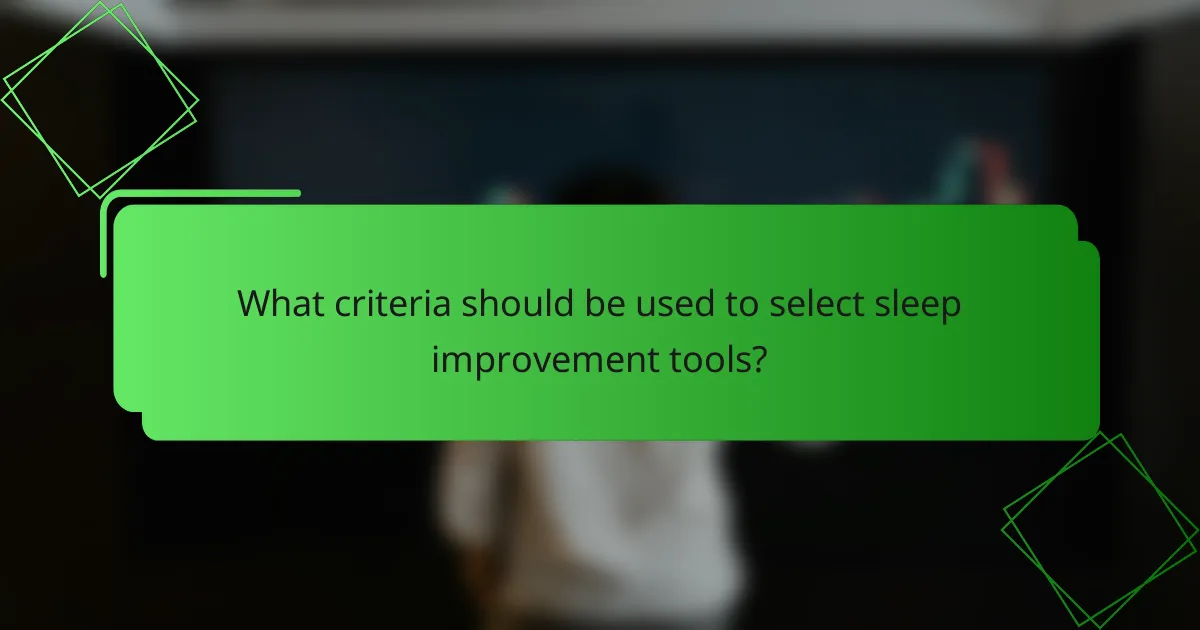Sleep improvement tools encompass a range of technologies and methods aimed at enhancing sleep quality, from tracking applications to devices that optimize the sleep environment. By providing insights and personalized recommendations, these tools help users identify patterns and make informed adjustments for better rest. User satisfaction can vary significantly, with many experiencing improved sleep quality and well-being, while others may encounter challenges in adapting to these new routines.

What are the most effective sleep improvement tools?
The most effective sleep improvement tools include a variety of technologies and methods designed to enhance sleep quality. These tools range from tracking applications to physical devices that create a conducive sleep environment.
Sleep tracking apps
Sleep tracking apps monitor your sleep patterns using your smartphone’s sensors or wearable devices. They provide insights into sleep duration, quality, and disturbances, helping you identify trends and areas for improvement.
When choosing a sleep tracking app, look for features like sleep stage analysis, smart alarms, and integration with other health apps. Popular options include Sleep Cycle and Fitbit, which offer user-friendly interfaces and actionable feedback.
White noise machines
White noise machines produce a consistent sound that masks background noise, creating a soothing environment for sleep. They can help individuals who are sensitive to disturbances, making it easier to fall and stay asleep.
Consider models with adjustable volume and sound options, such as nature sounds or fan noises. Prices typically range from $20 to $100, depending on features like portability and sound quality.
Smart mattresses
Smart mattresses adjust firmness and temperature based on your sleep preferences and movements throughout the night. These mattresses often come with integrated sleep tracking technology to provide personalized insights.
When selecting a smart mattress, evaluate features like sleep position detection and adjustable settings. Brands like Sleep Number and Tempur-Pedic offer various models, typically priced from a few hundred to several thousand dollars.
Sleep masks
Sleep masks block out light, creating a darker environment that promotes better sleep. They are particularly useful for light-sensitive individuals or those who sleep during the day.
Choose masks that are comfortable and adjustable, with materials that suit your skin sensitivity. Prices can range from $10 to $50, with higher-end options offering cooling features or additional light-blocking technology.
Relaxation apps
Relaxation apps provide guided meditations, breathing exercises, and calming sounds to help users unwind before sleep. These apps can reduce anxiety and promote relaxation, making it easier to transition into sleep.
Popular relaxation apps include Calm and Headspace, which offer free trials and subscription options. Look for features that resonate with your preferences, such as sleep stories or mindfulness exercises, to enhance your nighttime routine.

How do sleep improvement tools enhance sleep quality?
Sleep improvement tools enhance sleep quality by providing insights, personalized recommendations, and environmental adjustments tailored to individual needs. These tools leverage data and technology to help users identify patterns and make informed changes that promote better rest.
Data-driven insights
Data-driven insights utilize information gathered from sleep tracking devices or apps to analyze sleep patterns. These insights can reveal trends such as sleep duration, quality, and disturbances, helping users understand their sleep behavior. For example, a sleep tracker might show that users sleep better on nights when they avoid caffeine after a certain hour.
By reviewing this data, individuals can identify specific factors that affect their sleep quality, allowing them to make targeted adjustments. Regularly monitoring these metrics can lead to improved sleep habits over time.
Personalized recommendations
Personalized recommendations are tailored suggestions based on individual sleep data and preferences. Many sleep improvement tools offer customized advice, such as optimal bedtimes or relaxation techniques, to enhance sleep quality. For instance, a user might receive a recommendation to practice mindfulness meditation before bed if their data indicates high stress levels.
These recommendations can adapt over time as users input new data, ensuring that the guidance remains relevant and effective. This adaptability can significantly increase user satisfaction and engagement with the tool.
Environmental adjustments
Environmental adjustments focus on optimizing the sleep environment to promote better rest. This can include recommendations for room temperature, lighting, and noise levels. For example, a sleep improvement tool might suggest keeping the bedroom cool and dark to enhance sleep quality.
Users can implement these changes easily, such as using blackout curtains or white noise machines. Small adjustments in the sleeping environment can lead to noticeable improvements in sleep quality, making it a practical area for users to focus on.

What is user satisfaction with sleep improvement tools?
User satisfaction with sleep improvement tools varies widely based on individual experiences and specific products used. Many users report positive outcomes, such as better sleep quality and increased overall well-being, while others may find limited effectiveness or face challenges in adapting to new routines.
User reviews and ratings
User reviews and ratings provide valuable insights into the effectiveness of sleep improvement tools. Many platforms allow users to rate products on a scale, often revealing an average satisfaction rating that can range from low to high. For instance, sleep apps may receive ratings between 3 to 5 stars based on user feedback.
Common themes in reviews include ease of use, perceived effectiveness, and customer support. Users often highlight specific features that contribute to their satisfaction, such as personalized sleep plans or integration with wearable devices.
Comparative satisfaction studies
Comparative satisfaction studies assess user experiences across different sleep improvement tools, providing a broader perspective on effectiveness. These studies often involve surveys that measure user satisfaction levels and outcomes, revealing trends in preferences and effectiveness.
For example, a study might find that users of white noise machines report higher satisfaction compared to those using sleep masks, particularly in terms of sleep duration and quality. Such comparisons can guide potential users in selecting the right tool for their needs.
Case studies of successful users
Case studies of successful users illustrate how specific sleep improvement tools can lead to significant benefits. For instance, one case study might detail a user who improved their sleep quality by 30% after consistently using a sleep tracking app that provided tailored recommendations.
These success stories often emphasize the importance of commitment and the right tool selection. Users who actively engage with their chosen tools, such as maintaining a sleep diary or following guided relaxation techniques, tend to report better outcomes.

What are the pricing options for sleep improvement tools?
Sleep improvement tools come with various pricing options, catering to different user preferences and budgets. These options typically include subscription models, one-time purchases, and free trials or demos, allowing users to choose what best fits their needs.
Subscription models
Subscription models for sleep improvement tools often involve monthly or annual fees, providing ongoing access to features and updates. Prices can range from around $5 to $30 per month, depending on the tool’s complexity and included services.
These models may offer additional benefits, such as personalized recommendations or access to a community of users. However, users should consider whether they will use the tool consistently enough to justify the recurring cost.
One-time purchases
One-time purchases typically involve a single upfront payment for a sleep improvement tool, which can range from $20 to several hundred dollars. This option is common for physical products like sleep masks, sound machines, or apps that do not require ongoing fees.
While one-time purchases can be more economical in the long run, users should evaluate the tool’s effectiveness and longevity before committing. It’s also important to check for any potential additional costs, such as replacement parts or updates.
Free trials and demos
Many sleep improvement tools offer free trials or demos, allowing users to test the product before making a financial commitment. These trials typically last from a week to a month and can provide valuable insights into the tool’s effectiveness for individual needs.
When utilizing free trials, users should take note of cancellation policies to avoid unexpected charges. It’s advisable to fully explore the tool’s features during the trial period to assess its suitability for improving sleep quality.

What criteria should be used to select sleep improvement tools?
Selecting sleep improvement tools requires evaluating their effectiveness, user satisfaction, and compatibility with your lifestyle. Key criteria include features, user demographics, and how well the tools integrate with existing devices.
Feature comparison
When comparing features, consider the specific functionalities that each sleep improvement tool offers. Look for options like sleep tracking, soundscapes, and personalized recommendations. Tools may vary widely in their capabilities, so prioritize those that align with your sleep goals.
For example, some apps focus on meditation and relaxation techniques, while others emphasize tracking sleep patterns and providing analytics. Assess which features are most relevant to your needs to make an informed choice.
User demographics
User demographics play a significant role in the effectiveness of sleep improvement tools. Different age groups and lifestyles may respond differently to various tools. For instance, younger users might prefer tech-savvy solutions like smart sleep masks, while older adults may benefit more from traditional methods like white noise machines.
Understanding the target audience can help you choose a tool that resonates with your specific needs. Look for user reviews and testimonials from individuals similar to you to gauge satisfaction levels and results.
Compatibility with existing devices
Compatibility with existing devices is crucial for seamless integration into your sleep routine. Many sleep improvement tools work best when paired with smartphones, smartwatches, or home automation systems. Check if the tool you’re considering is compatible with your current devices to avoid frustration.
For instance, some sleep apps may require specific operating systems or Bluetooth connectivity. Ensure that the tool can easily sync with your devices for optimal performance and user experience.


